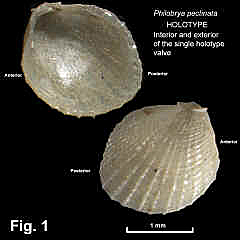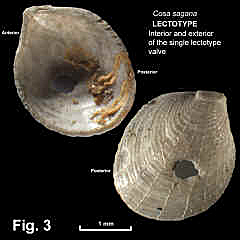|
|
PHILOBRYIDAE |
|
|
|
Cosa pectinata (Hedley, 1902) Description: Shell minute. Prodissoconch a flat or concave semicircular disc. Shape subovate, extended posteriorly. Anterior end straight or concave dorsally, rounded ventrally; posterior end smoothly rounded. Umbones at anterior end of hinge. Hinge line straight, with microscopic denticles, about 30 posteriorly and 15 anteriorly, separated by triangular ligament pit. Interior white, margin crenulated; margin often with 3 strong denticles in the postero-ventral region, and additional denticles in mature shells. Exterior with 12-30, strong, narrow radial ribs and weaker concentric ribs enclosing almost square spaces; concentric ribs vary from almost absent to moderately strong. Periostracum not seen. Shell colour white. Size: Up to 2.5 mm in length. Distribution: Known from southern Qld, southwards and around southern Australia, to SA including Tas. Habitat: Subtidal, 50-183 m. Common. Comparison: This is the most common species of Cosa in NSW. The number of radial ribs is variable, from 12- 30, and the shape of the shell varies somewhat in obliquity. It stands out by having the umbones at the anterior end of the hinge. Synonymy: Cosa sagana Iredale, 1931 (Fig. 3) is a synonym (NEW SYNONYM). Iredale described it as having “eight major rays”, but in Fig. 3, the lectotype of C. sagana, some 13 rays can be counted. Other specimens in the type lot (paralectotypes) show up to 19 radial ribs, which is typical of C. pectinata. The holotype of C. sagana is the specimen from the type lot with the least number of ribs. Fig. 1: HOLOTYPE 5-8 miles (8-12 km) off Port Kembla, NSW, depth 115-137 m (C.013257) Fig. 2: Figure from original description by Hedley (1902) Fig. 3: LECTOTYPE of Cosa sagana Iredale, 1931. 16 miles (25 km) east of Wollongong, NSW (C.018141) |
|

